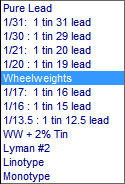Contents - Index - Previous - Next
Bullet Identification
After the ![]() button is clicked, a new record is inserted and the form displays all blank fields. As each field is populated with a value and then exited, calculations are made that require values from the previous entries. Therefore the initial entries into these fields must be made in the sequence indicated by the red numbers above each field.
button is clicked, a new record is inserted and the form displays all blank fields. As each field is populated with a value and then exited, calculations are made that require values from the previous entries. Therefore the initial entries into these fields must be made in the sequence indicated by the red numbers above each field.
Keep the following in mind when entering values in the sequential fields.
The Bullet Design Database that contains all the design records is keyed and sorted according to five record fields.
1. The Name field.
2. The Design field.
3. The Number field.
4. The As Cast Diameter Field.
5. The Bullet Weight Field.
No two records may have all the same five values in these fields. At least one field must have a different value or an error message will occur.

1. In order to eliminate misspellings and duplications the Name field is populated from an editable list of vendor names. If the desired name is not in the list then click the ![]() to open the vendor and bullet maker names
to open the vendor and bullet maker names
page, enter or edit the required name then return and select the name from the updated list.
2. The Design field is used to cryptically describe the physical characteristics of the bullet and is useful when searching a long list of records. A method that works well is to first describe the base band, then the grooves then the nose then the tip of the bullet.
3. The Number field is used to record the index or catalog number and should be unique to the bullet, suggesting the dimensions, design and weight of the bullet. A 3 part number works well. The first sector indicating the as-cast diameter, next, the diameter of the bullet nose (if a bore riding bullet) and last, the weight of the bullet cast from the appropriate alloy.
4. The Bore Groove Diameter value is primarily used to calculate the estimated ballistic coefficient of the bullet after it has been swagged to the groove diameter and exits the barrel.
5. As Cast Diameter is commonly one to two thousandths over bore groove diameter, however that is only a recommendation and may be whatever the circumstances dictate.
6.  The desired nose configuration is selected from a drop-down list. When entering values into a new record it is best to select the "Tangent Ogive" for the initial calculations. If another ogive configuration is desired it can be selected after exiting the #12 In-Case data field.
The desired nose configuration is selected from a drop-down list. When entering values into a new record it is best to select the "Tangent Ogive" for the initial calculations. If another ogive configuration is desired it can be selected after exiting the #12 In-Case data field.
7.  The tip configuration drop down list may use either Pointed, Flat or Round for the initial calculations and may be edited later.
The tip configuration drop down list may use either Pointed, Flat or Round for the initial calculations and may be edited later.
8.  The crimp type selection is not critical for initial calculations. The Spin-Edit value of the Crimp Length will be multiplied by 0.001 to determine the crimp length. (45 x 0.001 = 0.045" crimp length)
The crimp type selection is not critical for initial calculations. The Spin-Edit value of the Crimp Length will be multiplied by 0.001 to determine the crimp length. (45 x 0.001 = 0.045" crimp length)
9.  Use either the plain base or gas check Base Band values for initial calculations. The gas check shank diameters and length will be calculated from the values of the appropriate gas check stored in the Gas Check Database
Use either the plain base or gas check Base Band values for initial calculations. The gas check shank diameters and length will be calculated from the values of the appropriate gas check stored in the Gas Check Database
10.  Select the appropriate bullet alloy from the drop down list. The specific gravity of the selected alloy will be displayed in the Calculated Dimensions Box in the Alloy Density Grams/c.c. Field. The Grams/c.c. field may be edited without changing the value in the Alloy Type Field.
Select the appropriate bullet alloy from the drop down list. The specific gravity of the selected alloy will be displayed in the Calculated Dimensions Box in the Alloy Density Grams/c.c. Field. The Grams/c.c. field may be edited without changing the value in the Alloy Type Field.
Copyright ©, TMT Enterprises 2012